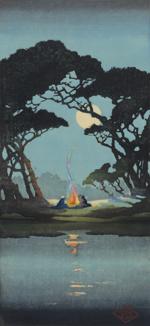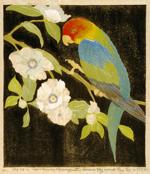Over the past year, mounting meaty exhibitions including works from far afield has been daunting, to say the least.
Unless, of course, you’re an institution like the Gibbes Museum of Art, which can curate from its own acclimatized closet. But, lest you think that refers to its hallmark miniature portraits and Charleston Renaissance artists, there is more to the story.
There is another sizable, if surprising, collection. It is one that may at first seem a bit of a head-scratcher for a Southern art museum, but its roots are real, and its breadth and depth are, too. And it even has ties with that aforementioned Charleston Renaissance trove.
Through Oct. 30, two companion exhibitions are up and running at the Gibbes: “Lasting Impressions: Japanese Prints from the Reads-Simms Collection” and “Japonisme in Charleston: Alice Smith and Her Circle.”
The thrust of this twofer comes from the museum’s own Reads-Simms Collection of Japanese Art. Yes, mainly tucked away and ripe for the mounting, the Gibbes holds 600 ukiyo-e woodblock prints. The current show shares 60 of them.
So just how did this sweeping yet intentional collection wind up in Charleston in the first part of the 20th century?

A gallery visitor takes in woodblock prints that are part of "Lasting Impressions: Japanese Prints from the Read-Simms Collection" at the Gibbes Museum of Art through Oct. 20, 2021. Gibbes Museum of Art/provided
Even with Charleston's post-Civil War poverty and inward-facing inclinations, the city’s luster still drew the culturally minded. Among them were New Orleans-based Mary Read Hume Simms and her first husband, Dr. Joseph Hume, as well as her brother Motte Alston Read and their mother Jane Alston Read, who both lived in Charleston.
According to the exhibition catalog publication (which avails of insights from Sebastian Izzard, a specialist in Japanese fine art focusing on ukiyo-e), when the Harvard-educated geologist Motte Alston Read moved to Charleston in 1909, he imported a penchant for Japanese art. By then, it was all the rage in Boston and other cities. The trend extended to Western artists, too, who tried their own hand at the art form in a style coined Japonisme.
Starting in 1947, the family began to donate the extensive collection of works they had started purchasing during their travels. Over the course of 12 years, the family gifted the 600 prints that are the Read-Simms Collection.
And they are not just any ukiyo-e works, mind you. They are the extraordinary output of its master artists. In Gallery 8, an orderly procession along the walls boasts 18th century icons like Suzuki Harunobu, Toshusai Sharaku and others, who were known to dramatize the celebrity actors of Kabuki Theater in the Edo.
In deftly gouged lines of despair and menace and cheer, the works freeze the actors at the pitch of drama, portraying centuries-old characters from warriors to wet nurses, sumo wrestlers to courtesans.
The show skips to the next century, too, with epic, if modestly sized, landscapes from the 19th century artists Utagawa Hiroshige and Katsushika Hokusai (whose famous mid-swell “The Great Wave of Kanagawa” remains a ubiquitous image throughout the West — just Google it for a plethora of licensed products bearing the image.)
Waves and other natural phenomena figure in here, too. Hokusai’s sketch “Plovers and Waves” (1830) offers the same expert flourish of arch and foam, at once ordered and wild. His “Sparrow, Cicada, and Clematis” (1830) frames flora and fauna in blithe interplay, at once flowing and composed.
Then there are Hokusai's “Thirty-six Views of Fuji,” which depict the prominent peak from various perspectives and points of arrival, snow-streaked and awash in still-rich russets and blues offset by swirling, cloud curlicues, or as a small triangle from afar, distant and majestic across expansive seas.
Hiroshige’s intricate lines similarly animate in his series “The Fifty-Three Stations of the Tokaido.” In “White Rain, Shono,” he swirls up a tumultuous summer storm, with figures struggling to forge ahead. In “Hakone, Traveling with Pine Torches,” voyagers contend with a formidable highway passage. The artist gets granular, too, detailing the plumage in “Parrot on a Branch of Flowering Crabapple” or chronicling a balletic descent in “Geese Flying before a Full Moon.”
That's where the Charleston Renaissance artists come in, one gallery over. Both fluid and formal, the Japanese woodblocks segue readily to the works featured in Gallery 9's “Alice Smith and Her Circle.”
Some, like Alice Ravenel Huger Smith, were inspired to do so by Motte Alston Read, who was her cousin, as well as visiting artist Helen Hyde. Others, like the adventurous Anna Heyward Taylor, had visited Japan.
However they came to the ukiyo-e aesthetic, the application of its principles in their contemporary works is as clear as a moonlit vista.

"Moonlight on the Cooper River," ca. 1919, by Alice Ravenel Huger Smith (American, 1876 - 1958); Woodblock print on paper; Gift of Alice Ravenel Huger Smith; Image courtesy of the Gibbes Museum of Art/provided.
Like the work of Hiroshige, Smith’s “Moon, Flower and Hawk Moth” offers a similar, indigo-saturated descent before a perfect lunar orb. Her “Untitled (Trees and Moss and Moon)" realizes tree top arcs as foamy and twilight blue, akin to Hokusai’s famed waves. “Moonlight on the Cooper River” frames figures huddling around fire in deeply green canopy through which that ever-full moon peaks.
And, while her techniques may have departed from those honed in Japan, Anna Heyward Taylor was drawn to the same natural subjects, swapping out a parrot for an indigenous beauty in “Carolina Paroquet” and sending a bird of local origins into a cresting, massive wave, made dramatic by thickly grooved woodcuts, in “Skimmer.”

"Carolina Paroquet, 1935," by Anna Heyward Taylor (American, 1879 - 1956); Wood-block print on paper; Gift of Anna Heyward Taylor; Image courtesy of the Gibbes Museum of Art/provided
Weighting these two artistic camps is likely something that only the Gibbes could pull off, particularly right now, both logistically and conceptually. The museum's vantage on Charleston Renaissance artists, as well as its Read-Simms Collection, together offer a worthwhile prism on both.
With their immersion into a culturally rich world of theater, visual art and poetry, the Japanese woodblock prints remain as vibrant as they were when trumpeting new theatrical productions and promoting the stars. It's no wonder the Western world became so besotted with them.
And, modish and exotic in early 20th century Charleston, the art form was an inroad for Charleston artists to reconsider familiar vistas and break from tradition with a rigorous chisel.
As those bold and powerful waves reared gloriously, and those finely featured creatures darted and dove with transcendent precision, the Japanese masters forged a new way of seeing Charleston, too.
Perhaps a revisit of them together can inform the city's next chapter, as artists, actors and poets once again aim to find a new way forward.
"Review" - Google News
May 11, 2021 at 04:30AM
https://ift.tt/3f9qSu3
Review: In a time of change, Charleston artists turned to Japan - Charleston Post Courier
"Review" - Google News
https://ift.tt/2YqLwiz
https://ift.tt/3c9nRHD
Bagikan Berita Ini


















0 Response to "Review: In a time of change, Charleston artists turned to Japan - Charleston Post Courier"
Post a Comment